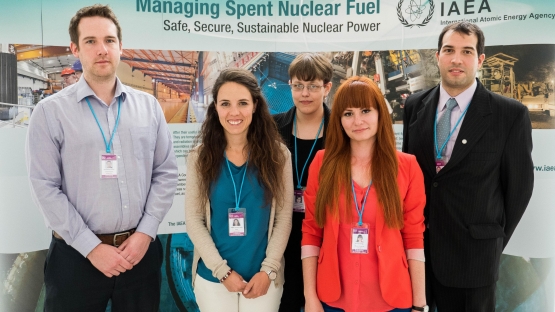Effective public engagement is key to the success of spent fuel management programmes, concluded experts at the end of a five-day conference on spent fuel management in Vienna last week. “There is a need to develop trust with key public stakeholders,” said Conference Chair Fiona Rayment of the National Nuclear Laboratory in the UK. “Where trust is strong, spent fuel solutions are easier to implement,” she said quoting Nuclear Energy Agency Director General Bill Magwood.
The industry needs to be clear with its stakeholders that nuclear energy is a safe, clean, reliable and economic energy resource that has an optimized waste and spent fuel management solution, Rayment summarized in her closing remarks.
Each country has specific polarized views on used fuel management – wet or dry storage, centralized or localized facilities, reprocessing or direct disposal, Rayment said. “We haven't resolved the optimum approach this week, and in fact that optimum approach may be different for each country, however having the discussion here enables the benefits and challenges for each option to be highlighted and discussed.”
Geological disposal up north
The over 200 conference participants received first-hand updates from the development of high-level waste depositories in Finland and Sweden. The two Nordic countries are on track to become the first in the world to place spent fuel and other high-level waste into long-term underground storage in the next decade. These deep geological disposal sites will use technology that encapsulates the fuel and protects them from erosion.
“It was interesting to hear and see what Finland and Sweden are doing in this field,” said Natalia Gomez Castano from the Nuclear Safety Council in Spain. “Other countries that are also looking for long-term storage solutions for spent fuel should learn from their experience.”
Castano is one of nine young nuclear professionals selected by the IAEA or nominated by national societies to attend the conference on the basis of their work or research activities related to spent fuel management.
An integrated approach to the back end of the fuel cycle
Nuclear power is expected to continue to play an important role in the world’s energy mix, and its increased use will lead to a corresponding increase in the amount of used fuel generated.
The back end of the fuel cycle generally refers to the processes which are necessary to safely manage, contain, and either reprocess or dispose of spent nuclear fuel. Discussions and presentations at the conference stressed the need to effectively manage used fuel through recycling and direct disposal. The fuel cycle needs to be considered in a holistic, fully integrated manner combining impacts on processing, storage, transport and disposal, participants agreed.
“I believe we have all convinced ourselves that an integrated approach to the back end of the nuclear fuel cycle is imperative for a successful nuclear energy programme over the long term,” Rayment said.
The conference allowed participants to consider technologies that could provide viable alternatives to what is used in their countries. “My country is in the design process of building a wet storage facility but economic factors are making us rethink our position,” said Lucas Souza from Brazil. “The sessions on dry storage have been helpful in informing us on the issues and the available technology.”
Bringing together those working in, supporting or making policies on spent fuel management enables us to demonstrate how spent fuel is being both responsibly and safely managed, said Paul Standring, a nuclear engineer at the IAEA and the scientific secretary of the conference.
An integrated approach to the back end of the nuclear fuel cycle is imperative for a successful nuclear energy programme over the long term.



